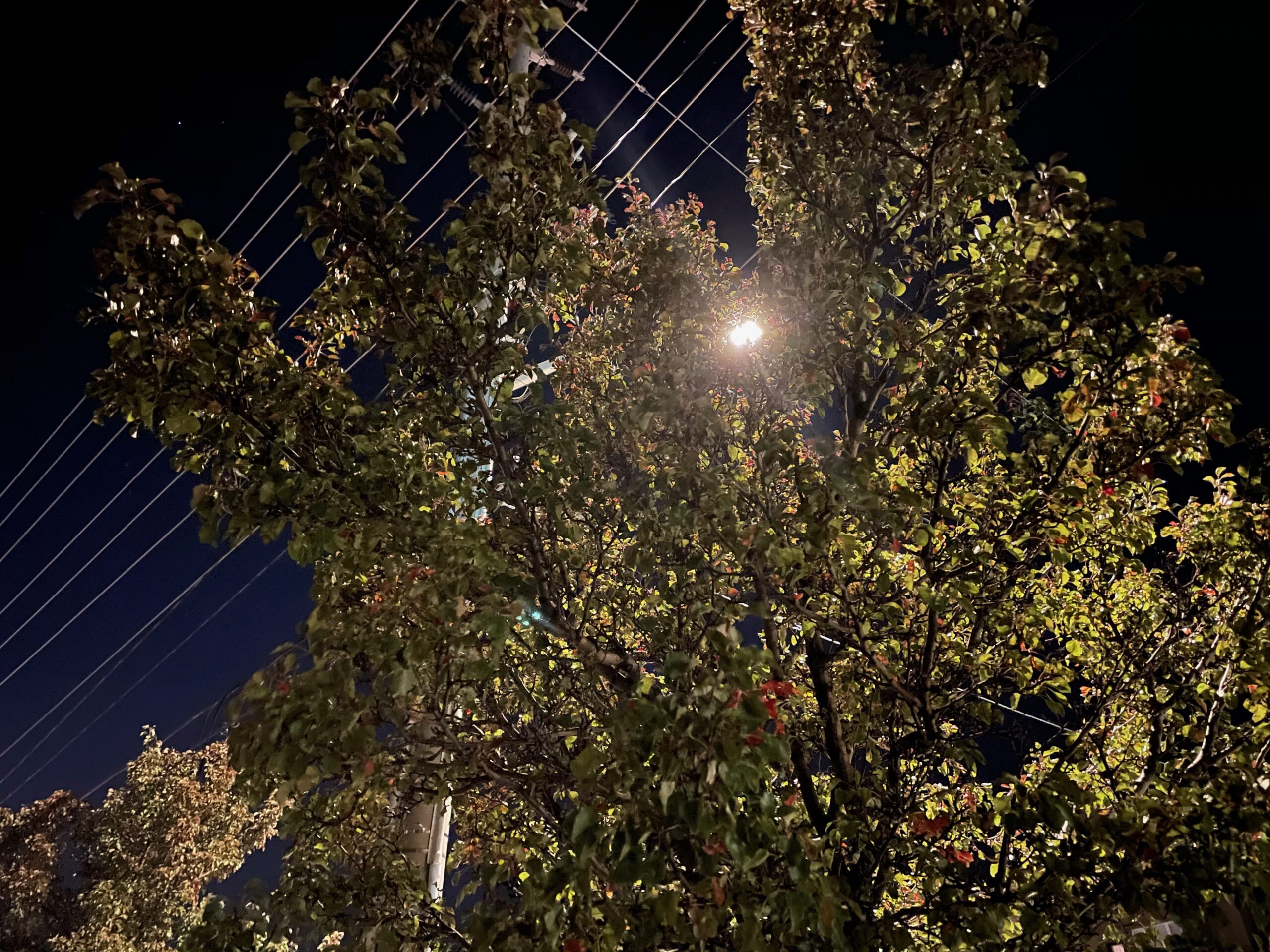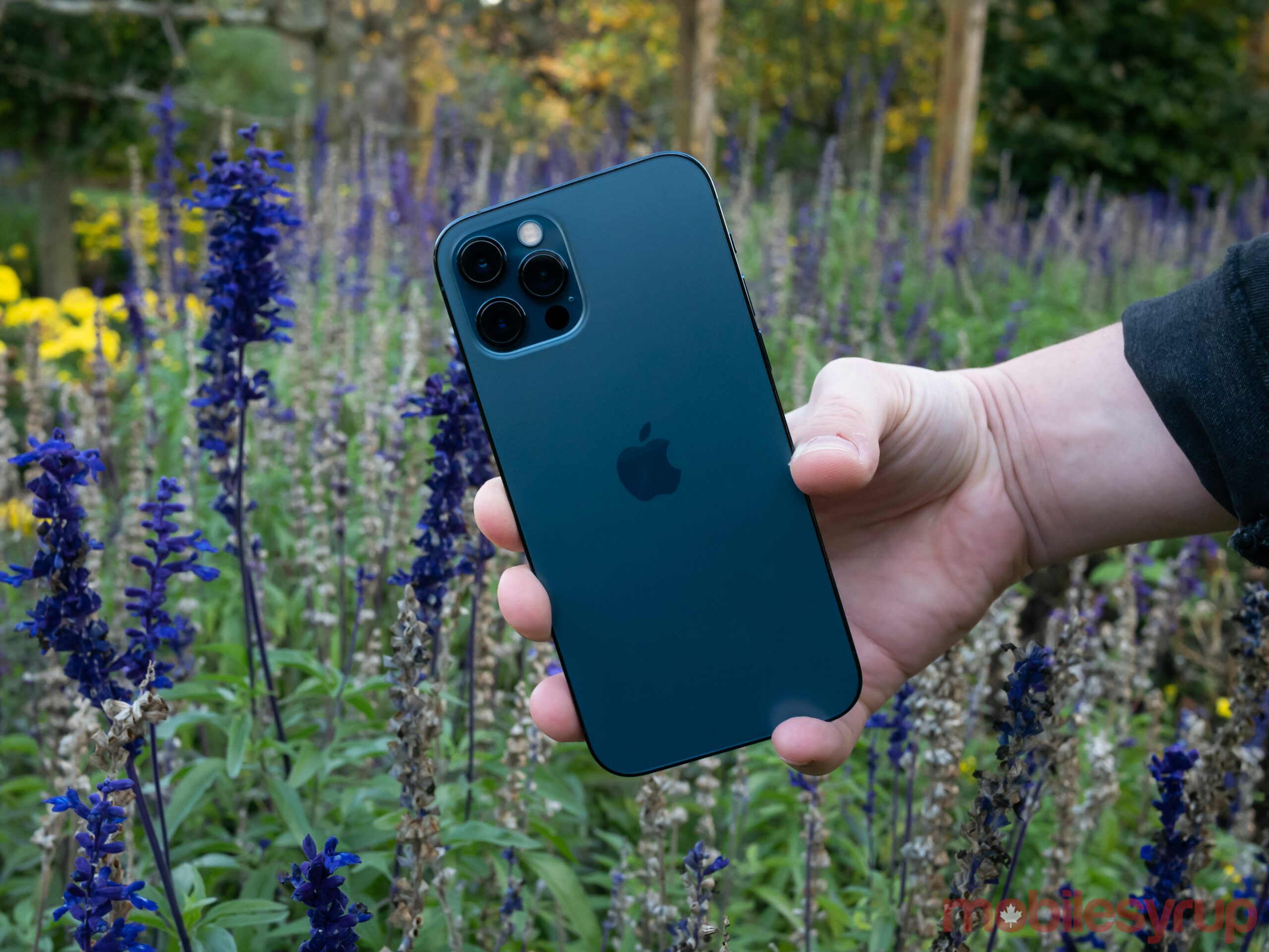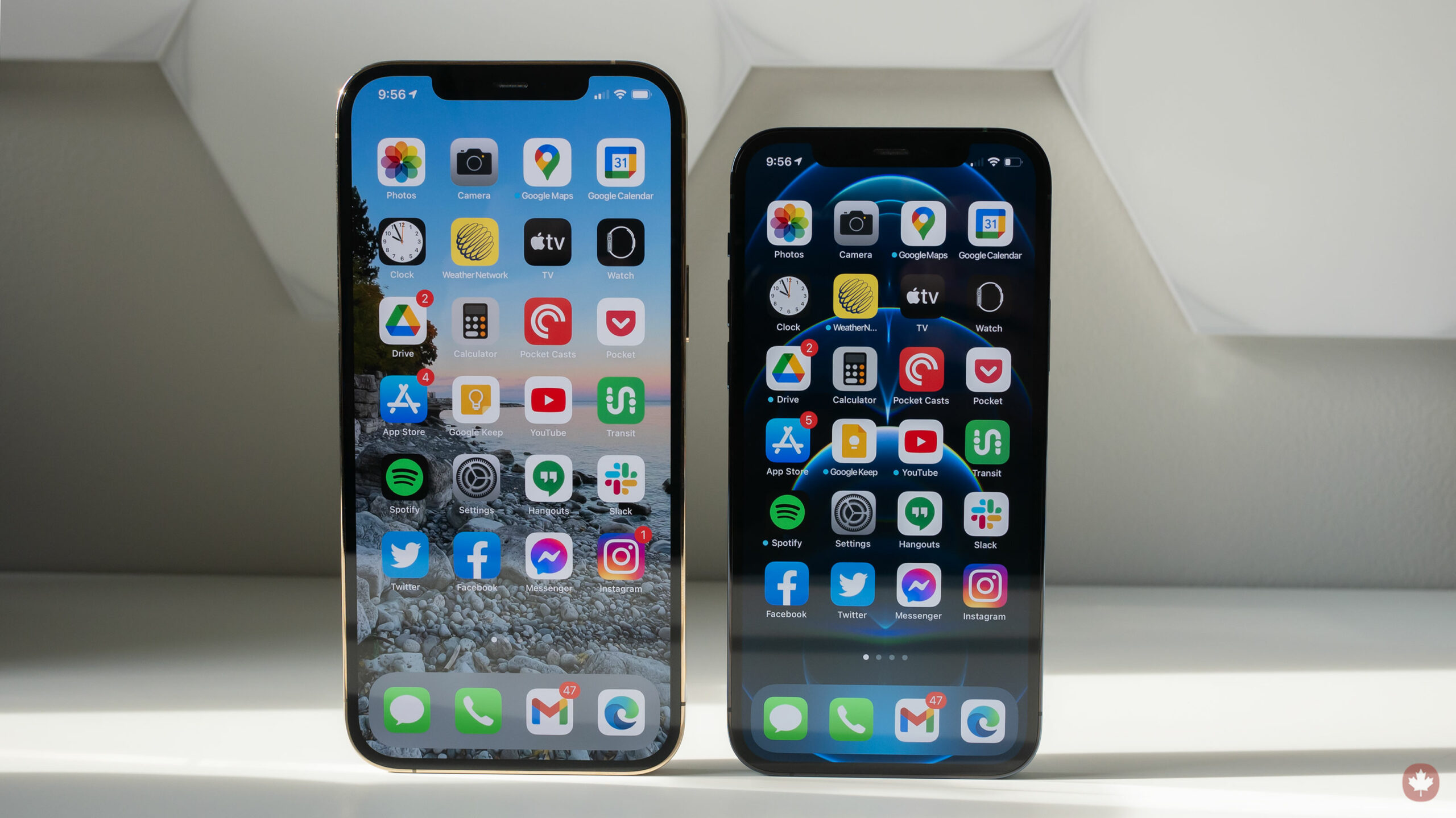
The Pros
- Redesign looks great
- Low-light performance is improved
- Incremental photography upgrades are great
The Cons
- iPhone 12 offers largely the same experience
- iPhone 12 Pro Max isn't a huge photography upgrade over the iPhone 12 Pro
- Expensive
Just like with every modern smartphone release, the most significant question surrounding Apple’s new iPhone 12 Pro and iPhone 12 Pro Max is if the new devices are worth the upgrade, especially on the heels of last year’s impressive iPhone 11 series update.
First, it’s important to note that the iPhone 12 series is the most significant refresh to the smartphone’s design since the release of the iPhone X, though it’s not an entirely new look. With that in mind, if you care about your smartphone’s aesthetic, the iPhone 12 Pro/12 Pro Max could offer a worthwhile update depending on how you feel about the device’s more squared-off design.

The other major change relates to improved low-light photography performance primarily powered by the iPhone 12 Pro and iPhone 12 Pro’s new Light Detection and Ranging (LiDAR) sensor and slightly redesigned camera array.
While most of Apple’s claims regarding the iPhone 12 Pro series’ camera improvements are accurate, they’re incremental. Still, if you’re a budding smartphone photography enthusiast, these updates could be substantial enough to warrant a purchase.

That said, there’s also the question of whether the ‘Pro’ series of iPhone 12 devices offer enough advantages at this point to even make them worthwhile for the average iPhone user.
There’s a lot to unpack with this year’s iPhones, so let’s get into it.
Update 09/11/2020: This review was updated with photos, image comparisons and information about the iPhone 12 Pro Max. The review score was not changed.
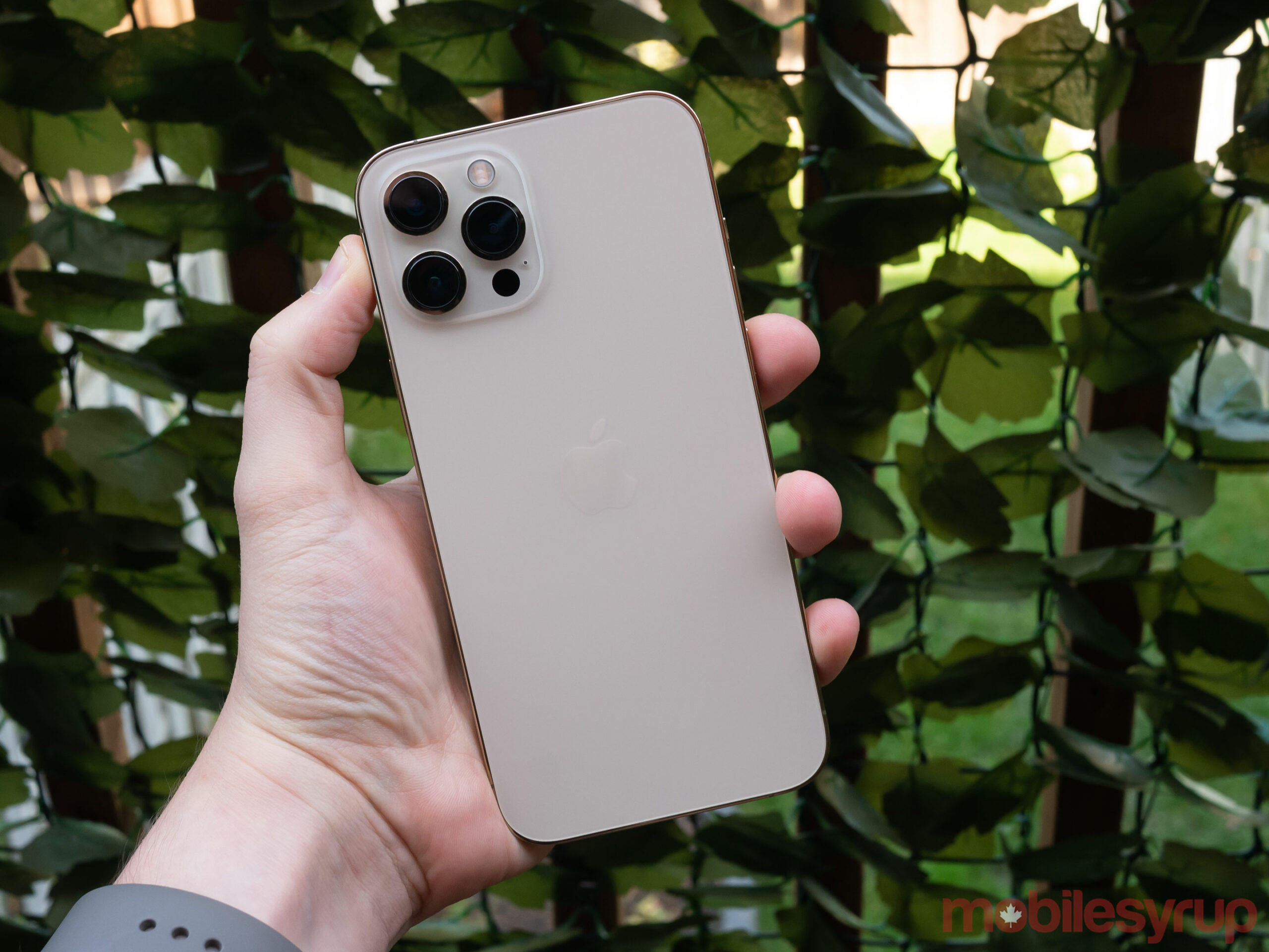
Specs
iPhone 12 Pro
iPhone 12 Pro Max
Display
6.1-inch, Super Retina XDR, OLED True Tone display, 2532 x 1170 pixels, HDR 10, Dolby Vision
6.7-inch, Super Retina XDR, OLED True Tone display, , 2778 x 1284 pixels, HDR 10, Dolby Vision
Processor
A14 Bionic chip
A14 Bionic chip
RAM
6GB of RAM
6GB of RAM
Storage
128GB, 256GB, 512GB
128GB, 256GB, 512GB
Dimensions (in.)
146.7 x 71.5 x 7.4mm
160.8 x 78.1 x 7.4mm
Weight
189g
228g
Rear Facing Camera
12-megapixel (f/1.6, OIS, wide angle) + 12-megapixel (f/2.0, OIS, telephoto 2x optical ) + 12-megapixel (f/2.4, OIS, ultra-wide angle)
12-megapixel (f/1.8, OIS, wide angle) + 12-megapixel (f/2.2, OIS, telephoto 2.5x optical ) + 12-megapixel (f/2.4, OIS, ultra-wide angle)
Front Facing Camera
12-megapixel (f/2.2)
12-megapixel (f/2.2)
OS
iOS 14
iOS 14
Battery
Up to 17 hours video playback
Up to 20 hours video playback
Network Connectivity
GSM/HSPA/LTE/5G
GSM/HSPA/LTE/5G
Sensors
Face ID, Three axis gyro, Accelerometer, Ambient light sensor, Barometer
Face ID, Three axis gyro, Accelerometer, Ambient light sensor, Barometer
SIM Type
Nano SIM, eSIM
Nano SIM, eSIM
Launch Date
October 13, 2020
October 13, 2020
Misc
Colours: Blue, Gold, Silver and Graphite
Colours: Blue, Gold, Silver and Graphite
Display
iPhone 12 Pro
6.1-inch, Super Retina XDR, OLED True Tone display, 2532 x 1170 pixels, HDR 10, Dolby Vision
iPhone 12 Pro Max
6.7-inch, Super Retina XDR, OLED True Tone display, , 2778 x 1284 pixels, HDR 10, Dolby Vision
Processor
iPhone 12 Pro
A14 Bionic chip
iPhone 12 Pro Max
A14 Bionic chip
RAM
iPhone 12 Pro
6GB of RAM
iPhone 12 Pro Max
6GB of RAM
Storage
iPhone 12 Pro
128GB, 256GB, 512GB
iPhone 12 Pro Max
128GB, 256GB, 512GB
Dimensions (in.)
iPhone 12 Pro
146.7 x 71.5 x 7.4mm
iPhone 12 Pro Max
160.8 x 78.1 x 7.4mm
Weight
iPhone 12 Pro
189g
iPhone 12 Pro Max
228g
Rear Facing Camera
iPhone 12 Pro
12-megapixel (f/1.6, OIS, wide angle) + 12-megapixel (f/2.0, OIS, telephoto 2x optical ) + 12-megapixel (f/2.4, OIS, ultra-wide angle)
iPhone 12 Pro Max
12-megapixel (f/1.8, OIS, wide angle) + 12-megapixel (f/2.2, OIS, telephoto 2.5x optical ) + 12-megapixel (f/2.4, OIS, ultra-wide angle)
Front Facing Camera
iPhone 12 Pro
12-megapixel (f/2.2)
iPhone 12 Pro Max
12-megapixel (f/2.2)
OS
iPhone 12 Pro
iOS 14
iPhone 12 Pro Max
iOS 14
Battery
iPhone 12 Pro
Up to 17 hours video playback
iPhone 12 Pro Max
Up to 20 hours video playback
Network Connectivity
iPhone 12 Pro
GSM/HSPA/LTE/5G
iPhone 12 Pro Max
GSM/HSPA/LTE/5G
Sensors
iPhone 12 Pro
Face ID, Three axis gyro, Accelerometer, Ambient light sensor, Barometer
iPhone 12 Pro Max
Face ID, Three axis gyro, Accelerometer, Ambient light sensor, Barometer
SIM Type
iPhone 12 Pro
Nano SIM, eSIM
iPhone 12 Pro Max
Nano SIM, eSIM
Launch Date
iPhone 12 Pro
October 13, 2020
iPhone 12 Pro Max
October 13, 2020
Misc
iPhone 12 Pro
Colours: Blue, Gold, Silver and Graphite
iPhone 12 Pro Max
Colours: Blue, Gold, Silver and Graphite
Don’t call it a throwback
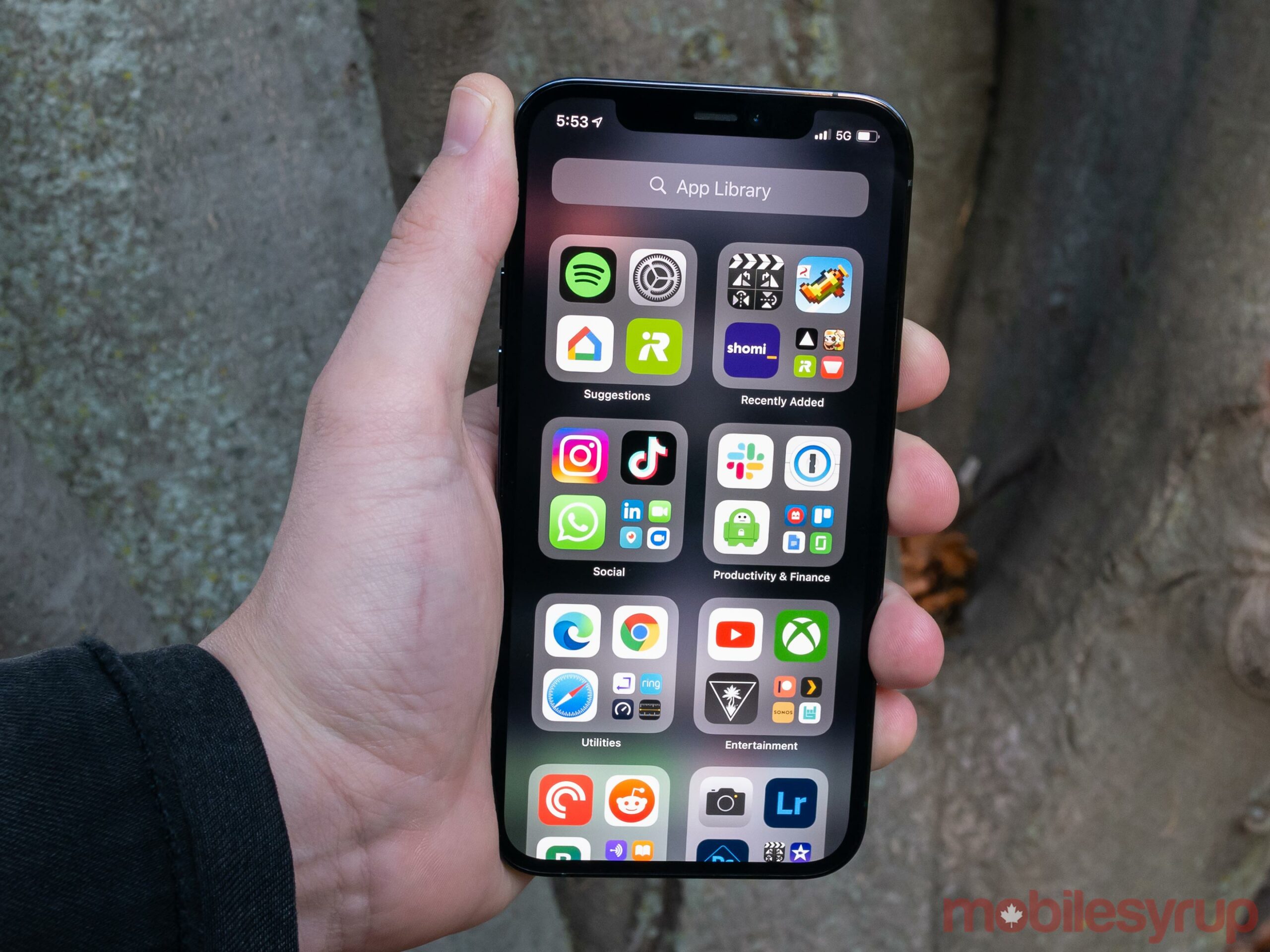
Despite the subheading above, the iPhone 12 Pro and iPhone 12 Pro Max are an obvious throwback to the iPhone 4-era of squared-off edges. However, the smartphones also clearly take inspiration from Apple’s more recent iPad Pro design and the iPad Air (2020).
At first, the iPhone 12 Pro/12 Pro Max’s squared-off look is jarring and feels equally strange when you’re holding the smartphone in your hand, but it’s grown on me over the last few weeks.
It gives the smartphone line a clear new design; place the iPhone X, iPhone XS or iPhone 11 Pro beside the new iPhone 12, and you’ll instantly recognize Apple’s new smartphones.

The squarer sides also make the device feel more substantial and easier to grip in your hand, which is great in this ongoing era of slippery smartphones. The power button remains on the device’s right side, with the volume buttons on the left. The buttons themselves have a fair amount of bounce to them, though they are flatter than those on the iPhone 11 series.
While the excellent, grease-resistant matte rear featured on the iPhone 11 Pro is back and complete with a new ‘Ceramic Shield’ construction the tech giant claims features four times better drop resistance, the stainless steel band running around the edge of the smartphone is an unfortunate callback to the iPhone X’s shiny border.

This means it attracts smudges and grease. Most people might not care about this, but it’s a strange blemish on an otherwise solid refresh of the high-end iPhone’s design. Strangely, the iPhone 12 doesn’t suffer from this same issue despite its lower-end aluminum sides.
It isn’t easy to verify Apple’s statements regarding the iPhone 12 Pro and iPhone 12 Pro Max’s improved durability regarding the new Ceramic Shield build.
“Overall, I like the new look of the iPhone 12 Pro and iPhone 12 Pro Max and view it as a positive step forward”
I’ll leave that up to wealthy YouTubers brave enough to test these claims out. However, what I can say is the iPhone 11 Pro Max I’ve been using for the last year is one of the most durable smartphones I’ve ever encountered, and, if Apple says it’s improved on that design, that is definitely a good thing.
With all that said, I’ve continually contended that everyone should at least be putting their smartphone in a case, with a high-end glass screen protector also being a good idea. Smartphones are pricey and accidents happen. Most tech YouTubers, bloggers, and journalists who claim they don’t use cases get sent so many smartphones that a broken device isn’t a big deal. This isn’t the reality for the average iPhone owner.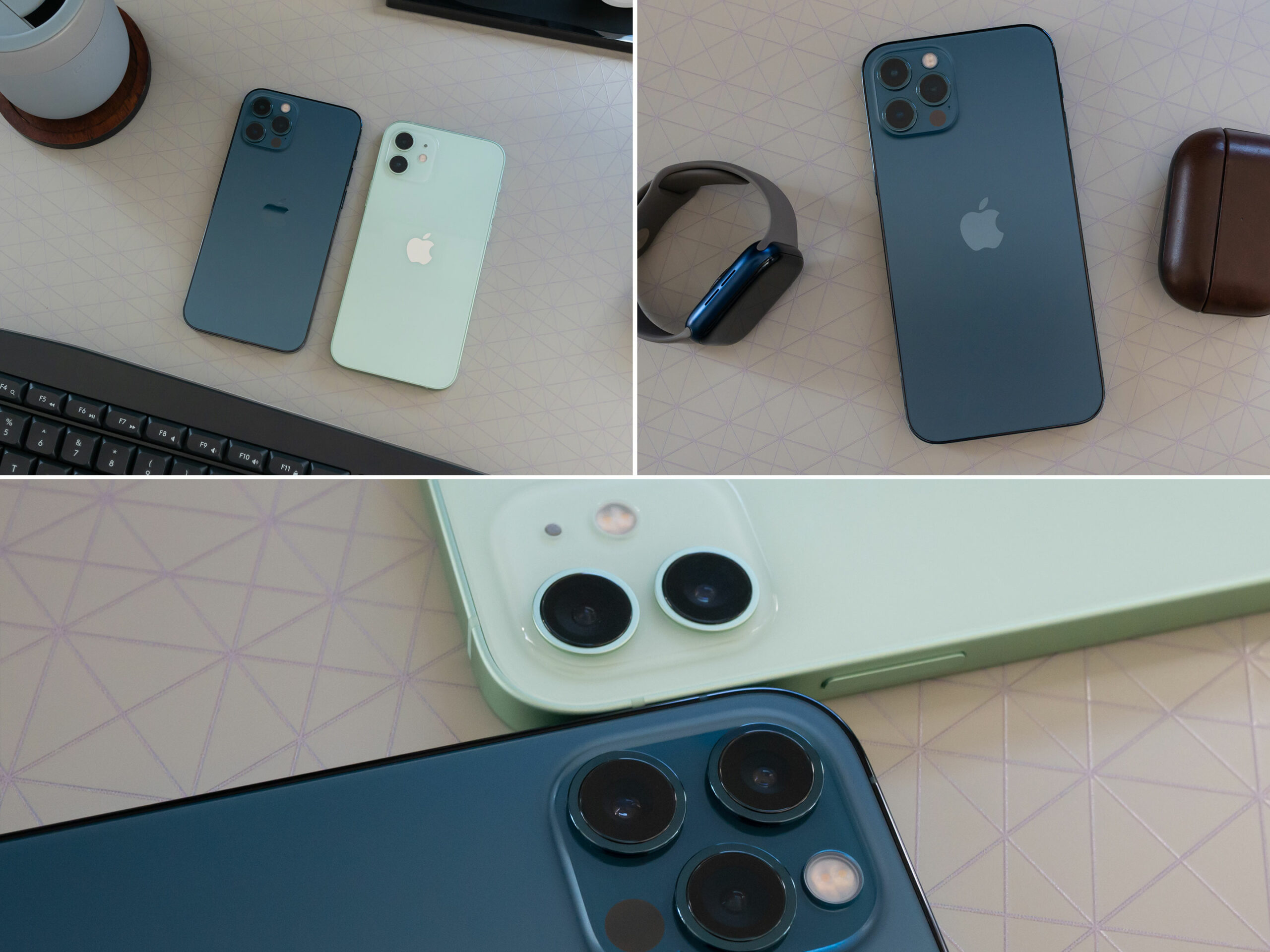
A LiDAR sensor now flanks the triple rear-camera setup with the same substantial camera bump as the iPhone 11 Pro. The display notch, which still isn’t as noticeable as some people make it out to be, returns with Face ID functionality that feels just as reliable as it was with the iPhone 11 Pro — this means it works roughly 95 percent of the time.
Regarding colours, the iPhone 12 Pro and iPhone 12 Pro Max are available in ‘Graphite,’ ‘Silver,’ ‘Gold,’ and ‘Pacific Blue.’ As you can see from the photos in this review, I have the Pacific Blue iPhone 12 Pro and the Gold iPhone 12 Pro Max. While the blue actually seems deeper than last year’s now-dead ‘Midnight Green,’ the new gold hue is surprisingly subdued. Though I like the new Pacific Blue colour, Midnight Green will likely forever go down as my favourite smartphone colour.
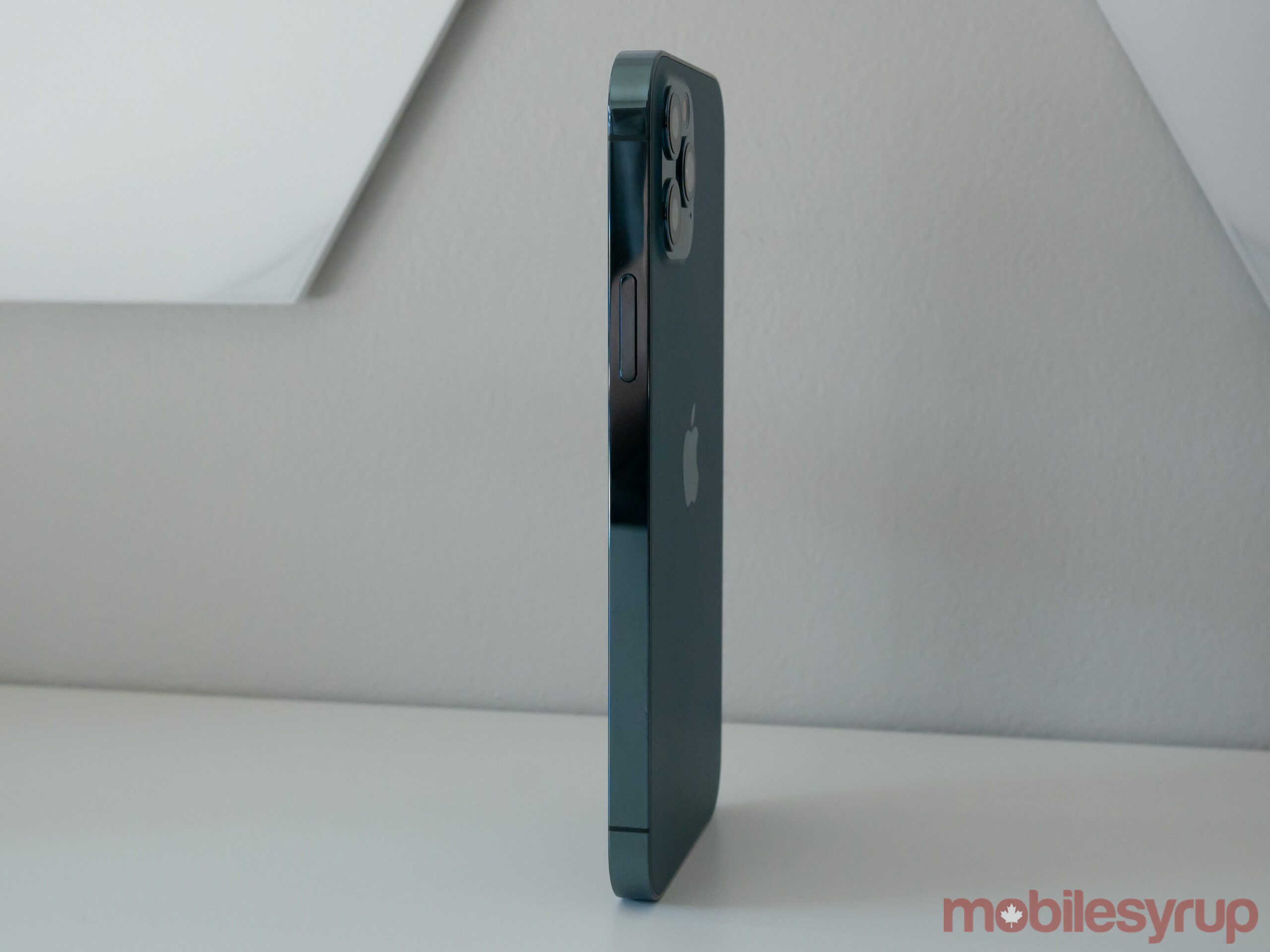
Overall, I like the new look of the iPhone 12 Pro and iPhone 12 Pro Max and view it as a positive step forward.
Processor Power

Apple’s new A14 Bionic processor is an absolute powerhouse. The A13 was a leap above anything Qualcomm has produced and the A14 pushes that power even further.
For those who care about benchmarks, the iPhone 12 Pro comes in at 1,597 for single-core performance and 4,232 for multi-core. On the other hand, the iPhone 11 Pro Max hits 1,328 for single-core and 3,397 for multi-core.
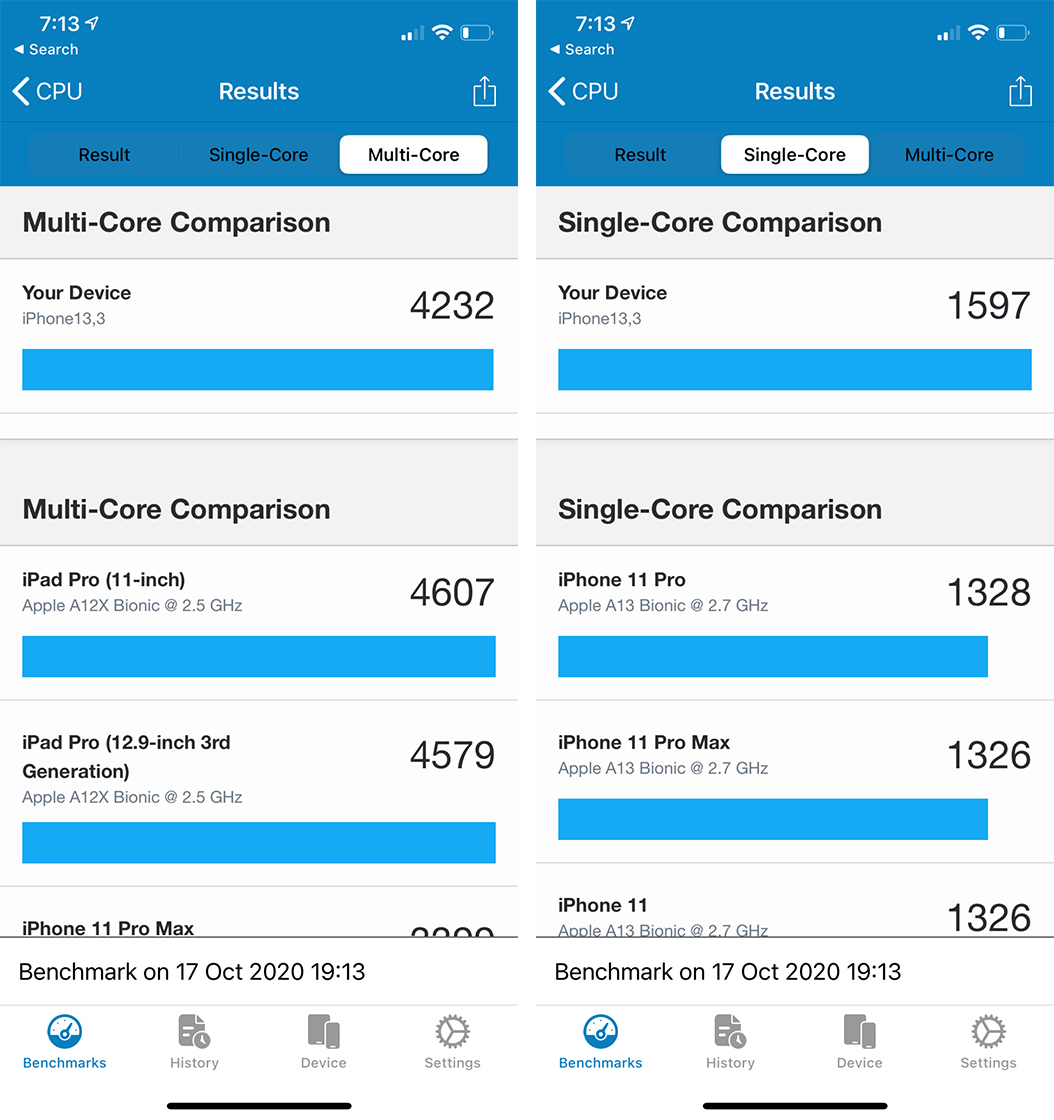
My experience with the phone, whether I’m playing games like REKT, doing quick photo edits with Lightroom, browsing the internet or watching content on Netflix, has been extremely smooth.
I haven’t encountered a single instance of lag during my time with the iPhone 12 Pro or iPhone 12 Pro Max.
There’s also the new LiDAR sensor that improves the iPhone 12 Pro series’ augmented reality functionality, just like the iPad Pro (2020), while adding faster autofocus in low-light and other camera improvements (more on this later).
“Everything from watching Netflix, to gaming, to just browsing the internet looks stellar on the screen”
I’ve always preferred Apple’s ‘Max’ model of iPhones. I appreciate the additional real-estate the devices offer, so using a 6.1-inch smartphone for part of this review has been a strange experience for me. That said, I don’t necessarily find the iPhone 12 Pro too small, especially since it’s an increase over the 5.8-inch iPhone 11 Pro’s size. Along with its larger display size, the iPhone 12 Pro’s screen measures in at a slightly higher 2,523 x 1,170 pixels compared to the iPhone 11 Pro’s 2,436 x 1,125 pixels.
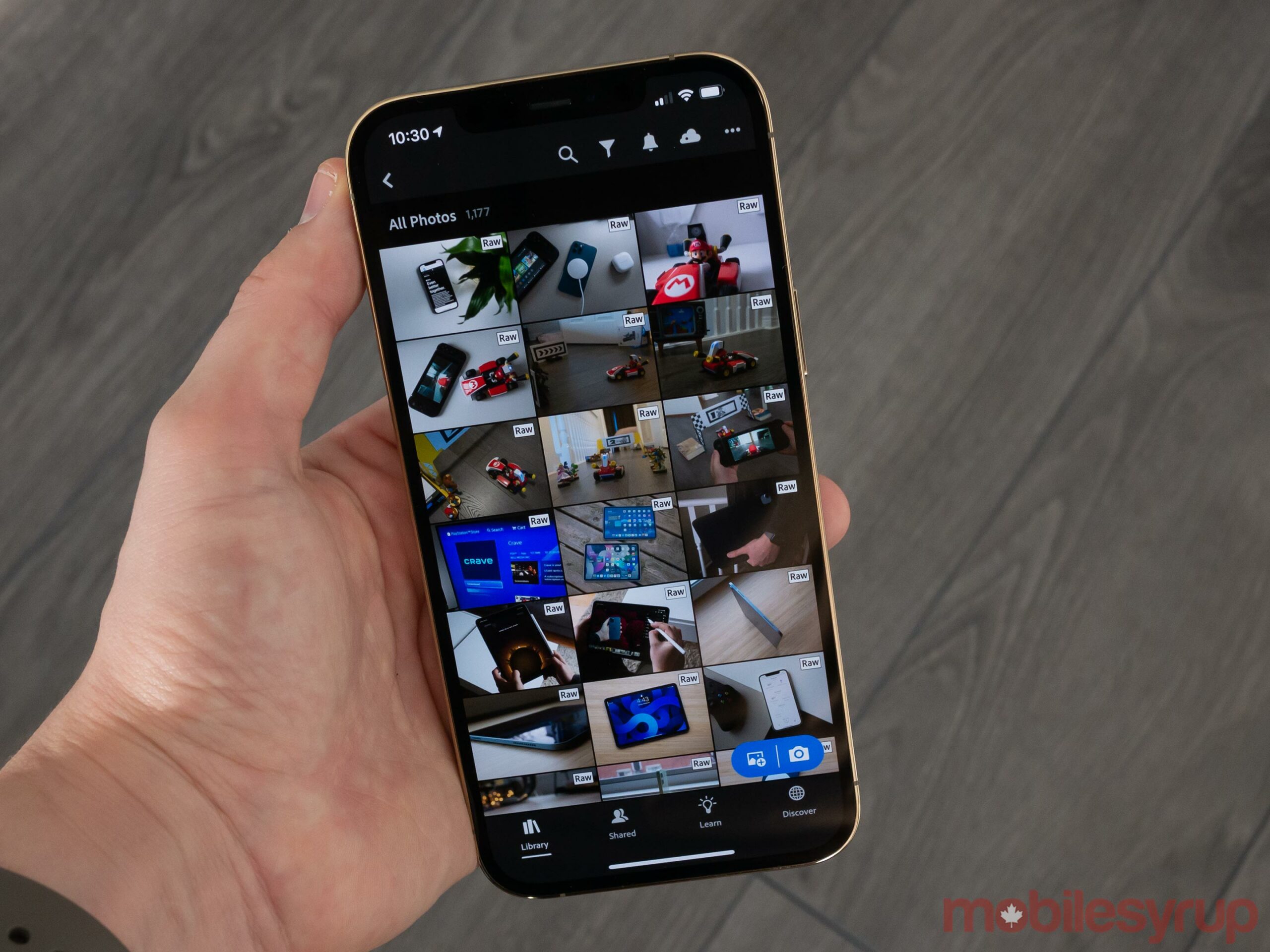
On the other hand, the iPhone 12 Pro Max comes in at an expansive 6.7-inches and a 1,284 x 2,778 pixel resolution compared to last year’s 6.5-inches and a 1,232 x 2,688 pixel resolution. The 12 Pro Max is slightly taller than the iPhone 11 Pro Max, but manages to feature an 87.4 percent screen-to-body ratio, a slight improvement over last year’s 83.7 percent screen-to-body ratio with the iPhone 11 Pro Max.
While only a minor overall increase in display size, you really do notice that the iPhone 12 Pro Max’s screen is larger when looking at it directly beside the iPhone 11 Pro Max’s display. This makes watching videos, typing and performing nearly any task a great experience as long as your fine with using a large smartphone.
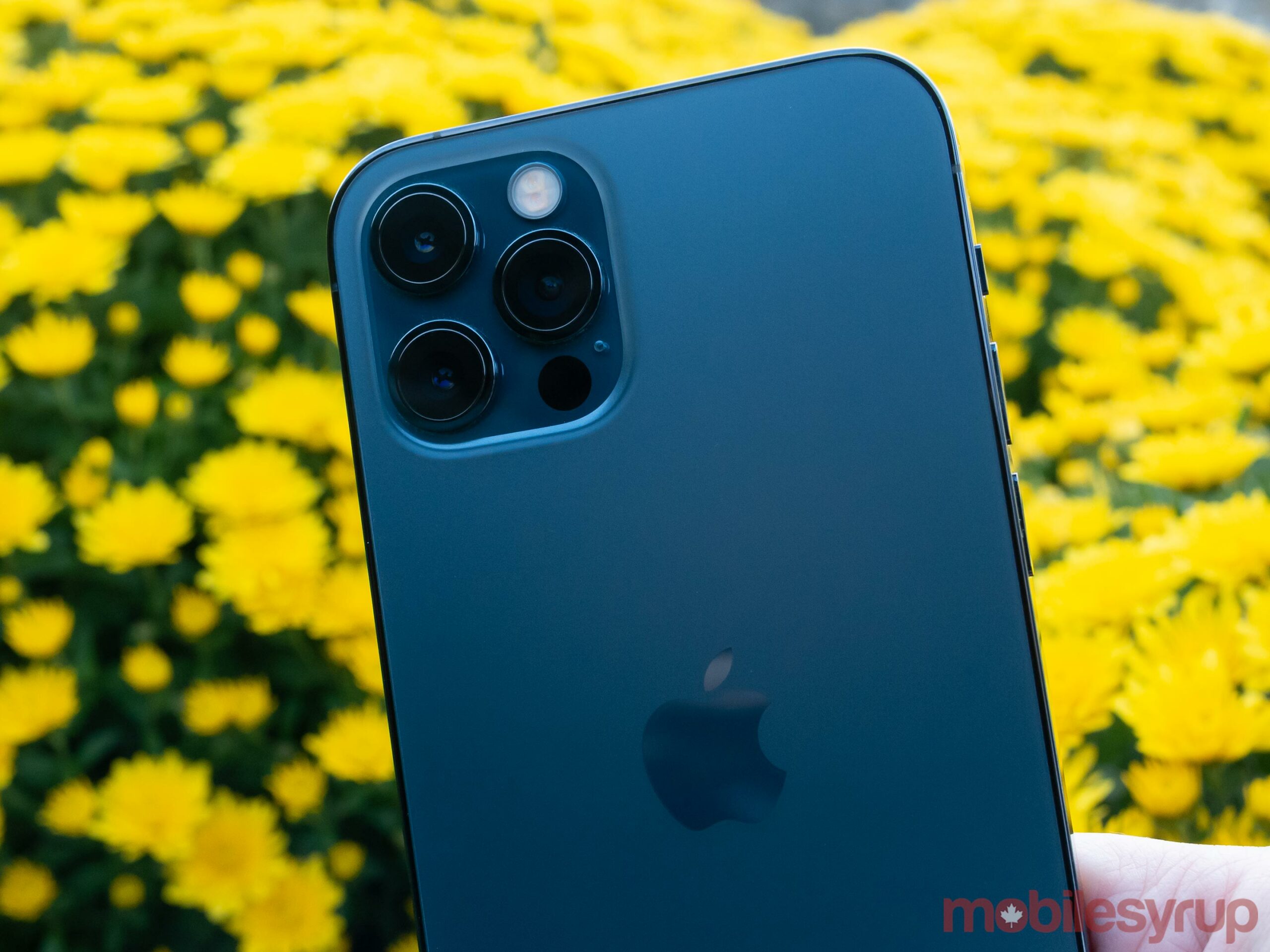
The display itself matches Samsung’s recently released Galaxy Note 20 Ultra in terms of vibrancy and colour, thanks to its P3 wide colour gamut with a 2,000,0000:1 contrast ratio and 1200 nits max brightness with HDR10 support. Everything from watching Netflix, to gaming, to just browsing the internet looks stellar on the screen.
Unfortunately, rumours surrounding the iPhone 12 Pro and iPhone 12 Pro Max’s display featuring a 120Hz refresh rate proved inaccurate. Whether there were concerns that 120Hz coupled with 5G would result in poor battery life or COVID-19 related manufacturing issues, the iPhone 12 Pro/12 Pro Max’s screen comes in at just 60Hz.
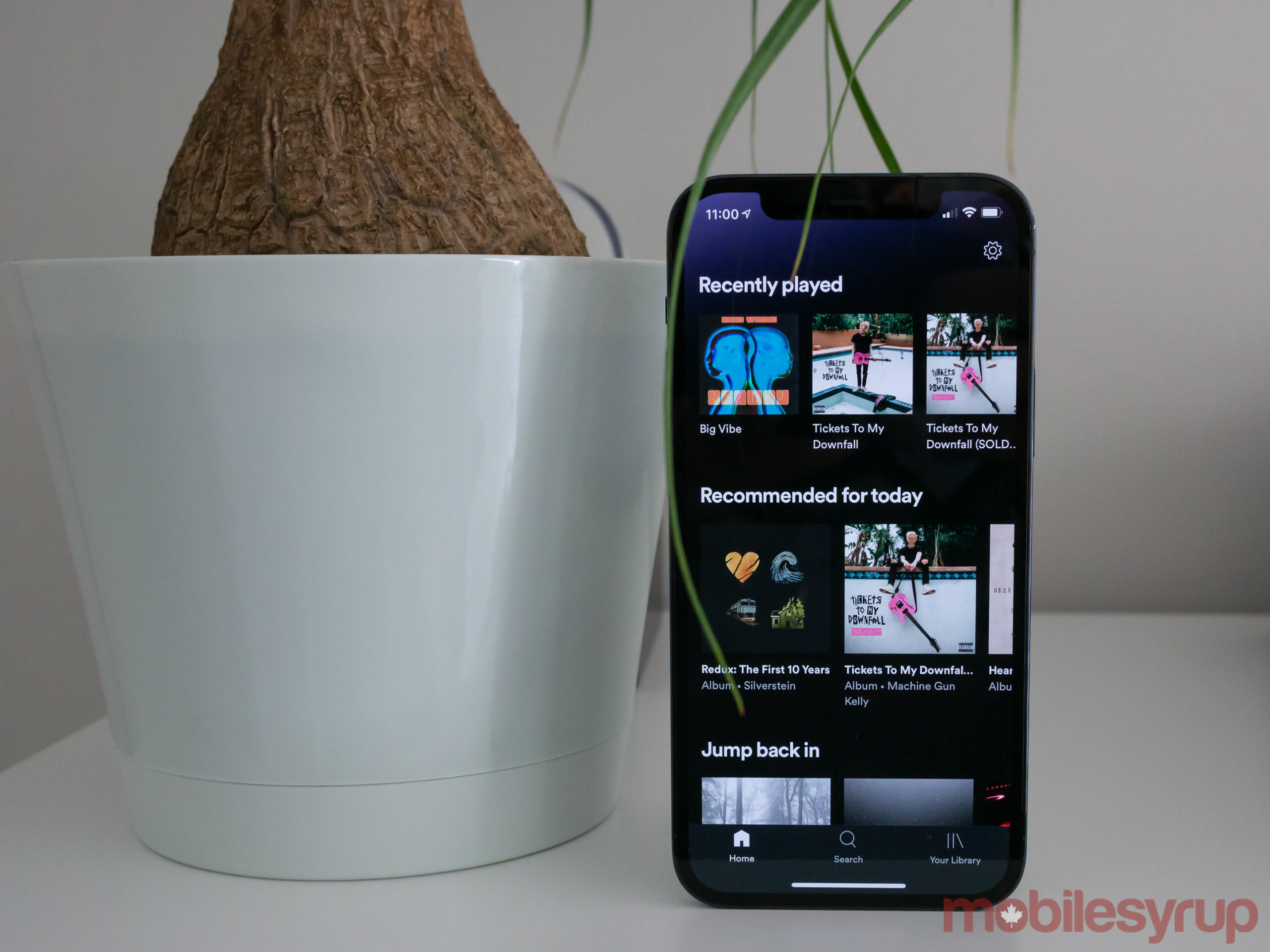
In some ways, this is totally unacceptable. Most high-end — and, in some cases, even mid-range Android devices — have moved on to smoother 90Hz and 120Hz displays. Even the iPad Pro features Apple’s great-looking ‘ProMotion’ 120Hz technology. In 2020, it seems strange for the tech giant’s flagship not to include a higher refresh rate display.
On the other side of this argument, while 120Hz is great, it’s not a feature most people will miss given that the difference isn’t drastic and really depends on the type of content you’re consuming. Still, it would have been great to see Apple bring a 120Hz refresh rate technology to the iPhone this year.

Storage size starts at 128GB compared to last year’s 64GB, which is a good move on Apple’s part considering the tech giant’s smartphone line lags behind most of its Android competitors in the storage department.
Another spec worth noting includes that the iPhone 12 Pro series is still IP68 rated, though this time to a maximum of 6 metres for up to 30 minutes instead of 4 metres for 30 minutes like last year.
And, of course, the iPhone 12 Pro and iPhone 12 Pro Max still feature a Lightning port and not USB-C. At this point, it’s more likely Apple will ditch a connector port and go entirely wireless rather than switch to USB-C. I’ve tested out Apple’s MagSafe charger and can confirm that it attaches to the iPhone 12 Pro’s rear extremely easily. However, the charger, unfortunately, doesn’t come with a USB-C charging brick.
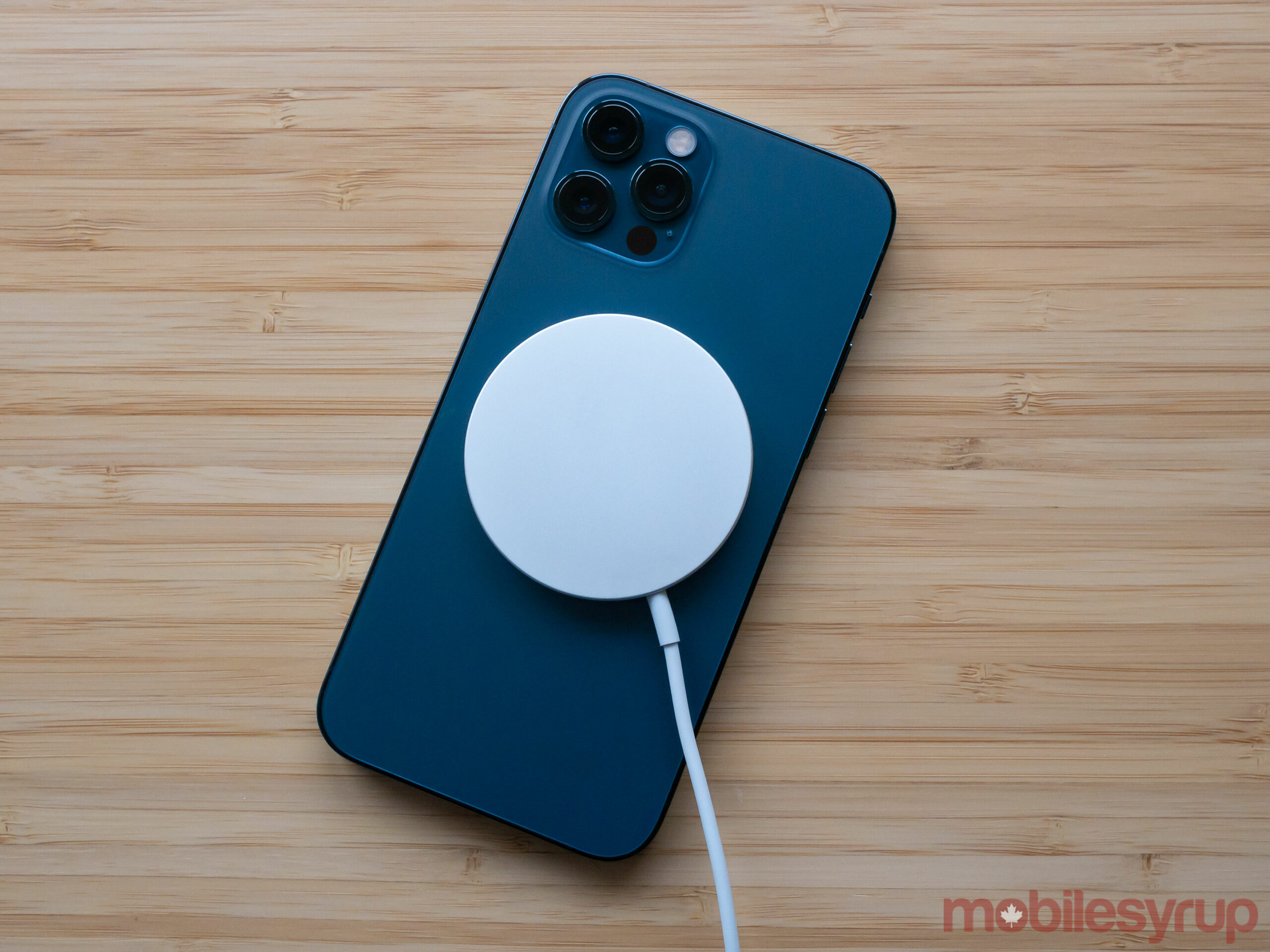
Apple’s various MagSafe charging cases are very similar to the standard leather and silicone smartphone enclosures the tech giant has released for years. They’re pricey, coming in at $69, but generally feel great and firmly attach to the new MagSafe charger. It’s worth noting that MagSafe still works with standard cases; the magnetic connection will just be slightly less firm. I haven’t tried Apple’s MagSafe Wallet attachment, but early impressions of the accessory are generally negative. The attachment seems to far too easily fall off the rear of Apple’s iPhone 12 MagSafe cases.
Regarding the iPhone 12 Pro’s battery life, I found that the phone comes in at roughly a day with moderate use, which matches my experience with last year’s iPhone 11 Pro Max. I experienced very similar results with the iPhone 12 Pro Max, though its slightly larger battery allowed me to get one or two hours more out of the device.
Incremental but still worthwhile camera upgrades

Camera-wise, there are several minor improvements to the iPhone 12 Pro’s array of shooters. First, the main wide 12-megapixel camera now features a wider f/1.6 aperture and a seven-element lens compared to the iPhone 11 Pro’s six-element f/1.8 lens. Apple says this improves the lens’ ability to gather more light by 27 percent.
In my experience, I didn’t notice a significant difference in performance, but this lens does seem to shoot slightly less noisy photos.
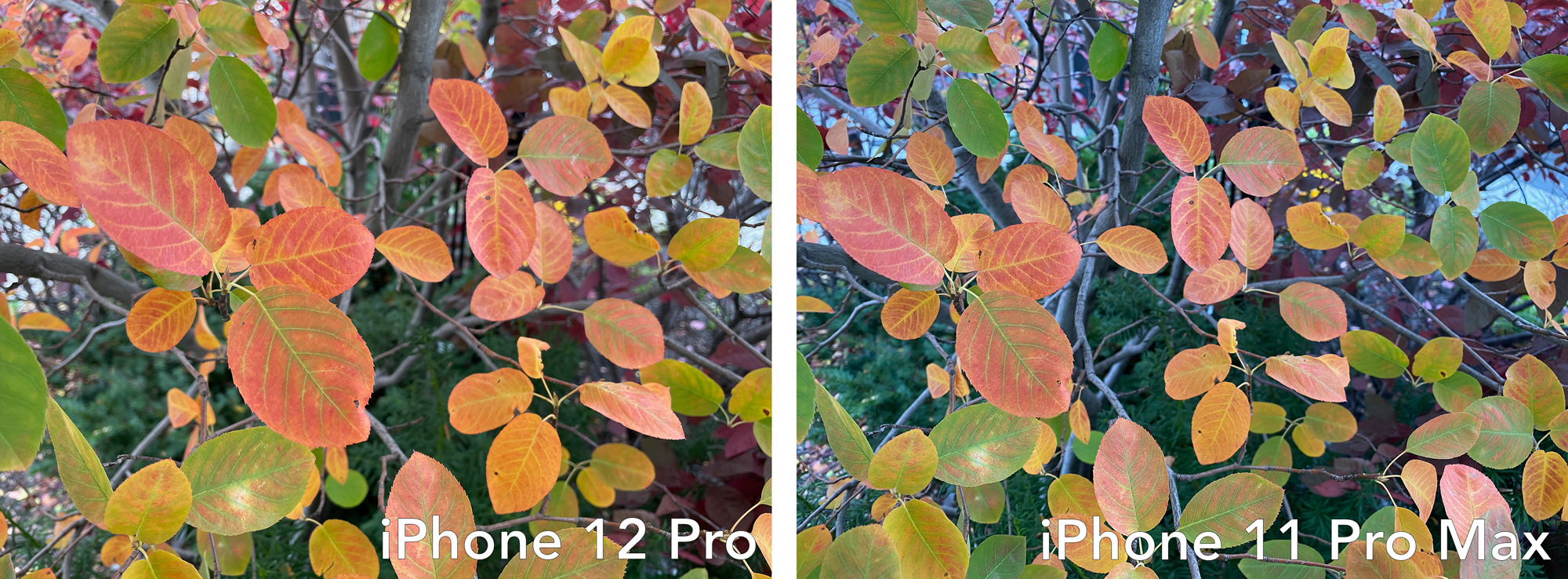
The left image is shot with the iPhone 12 Pro, and the image on the right is shot with the iPhone 11 Pro Max. The iPhone 12 Pro photo features far more accurate colour tones than its iPhone 11 Pro Max counterpart.
On the other hand, the 12-megapixel f/2.4 ultrawide angle and the f/2.0 with 2x optical zoom lenses still measure in with the same technical specs as last year.
The real camera improvements come from the smartphone’s Smart HDR 3, the latest version of Apple’s behind-the-scenes image processing technology. Photos taken with the iPhone 12 Pro feature more detail, slightly greater contrast, more accuracy, greater colour vibrancy and, in general, look better than those shot with the iPhone 11 Pro Max, but only by a small margin.
Just like with last year’s iPhones, the images also look more true-to-life than the oversaturated photos snapped by smartphones like Samsung’s Note 20 Ultra.
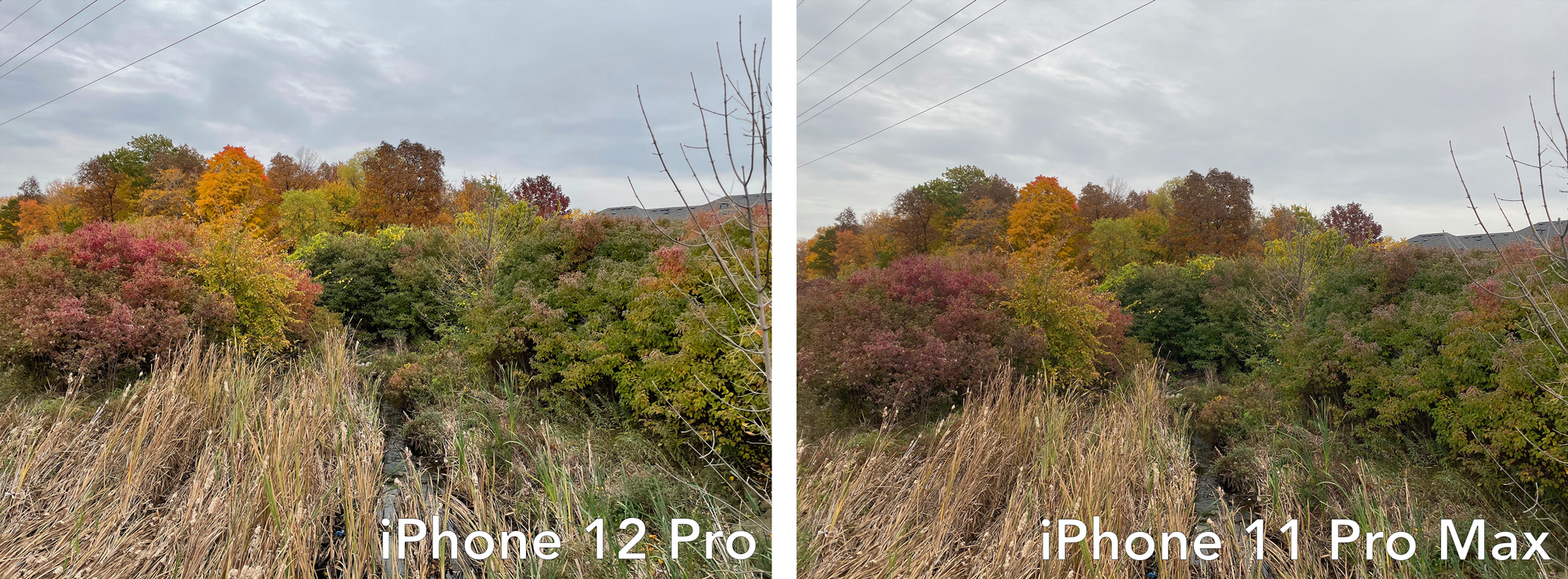
The iPhone 12 Pro’s standard wide camera is on the left, and the iPhone 11 Pro Max’s shooter is on the right. The photo shot with the iPhone 12 Pro features more vibrant, accurate colour and more detail in the foliage.
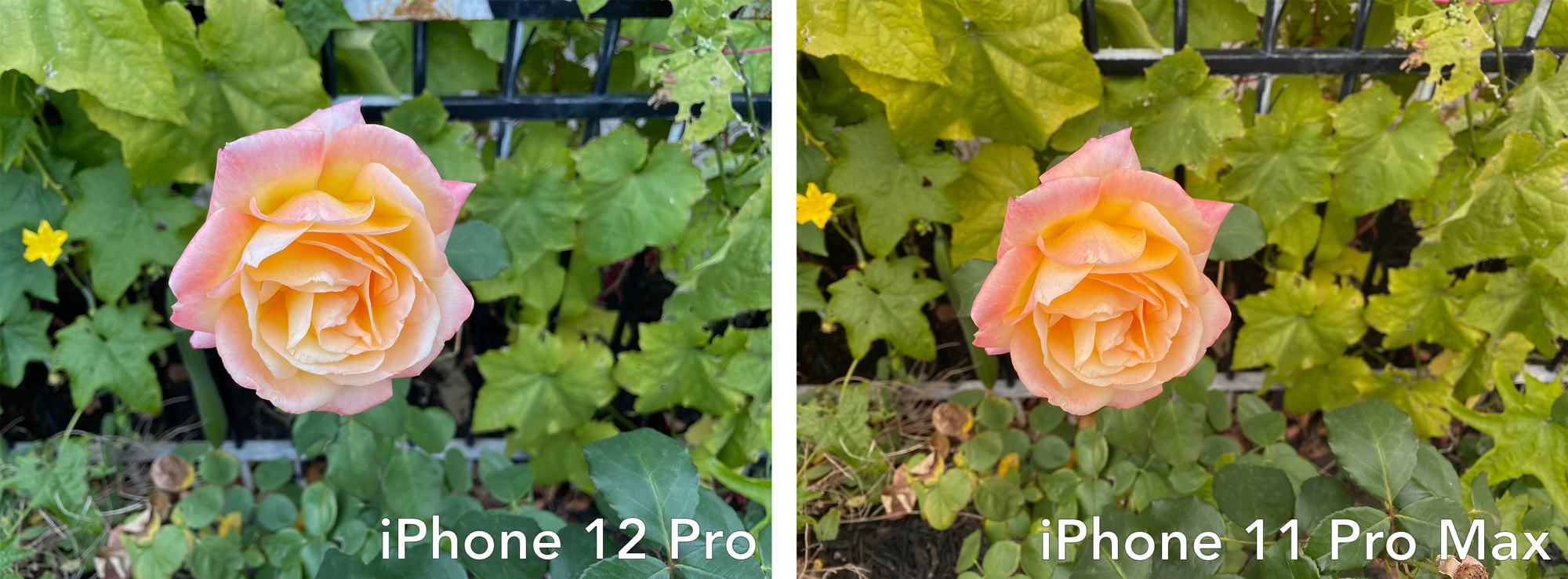
The iPhone 12 Pro’s regular wide camera is on the left, and the iPhone 11 Pro Max’s shooter is on the right. The iPhone 12 Pro photo features more accurate white balance and tones. It’s also slightly sharper than the photo shot with the iPhone 11 Pro Max.
On the iPhone 12 Pro Max side of the camera equation, the larger smartphone’s primary sensor is bigger and utilizes 1.7-micron pixels, allowing it to capture more light. Generally, low-light performance with the iPhone 12 Pro Max is slightly better than what the iPhone 12 Pro is capable of.
Further, the iPhone 12 Pro Max’s telephoto lens comes in at 65mm f/2.2 compared to the iPhone 12 Pro’s 52mm f/2.0. While the aperture is smaller, this allows the Pro Max to shoot 2.5x optical zoom. While the additional zoom does come in handy when snapping shots from a distance, the difference is negligible.
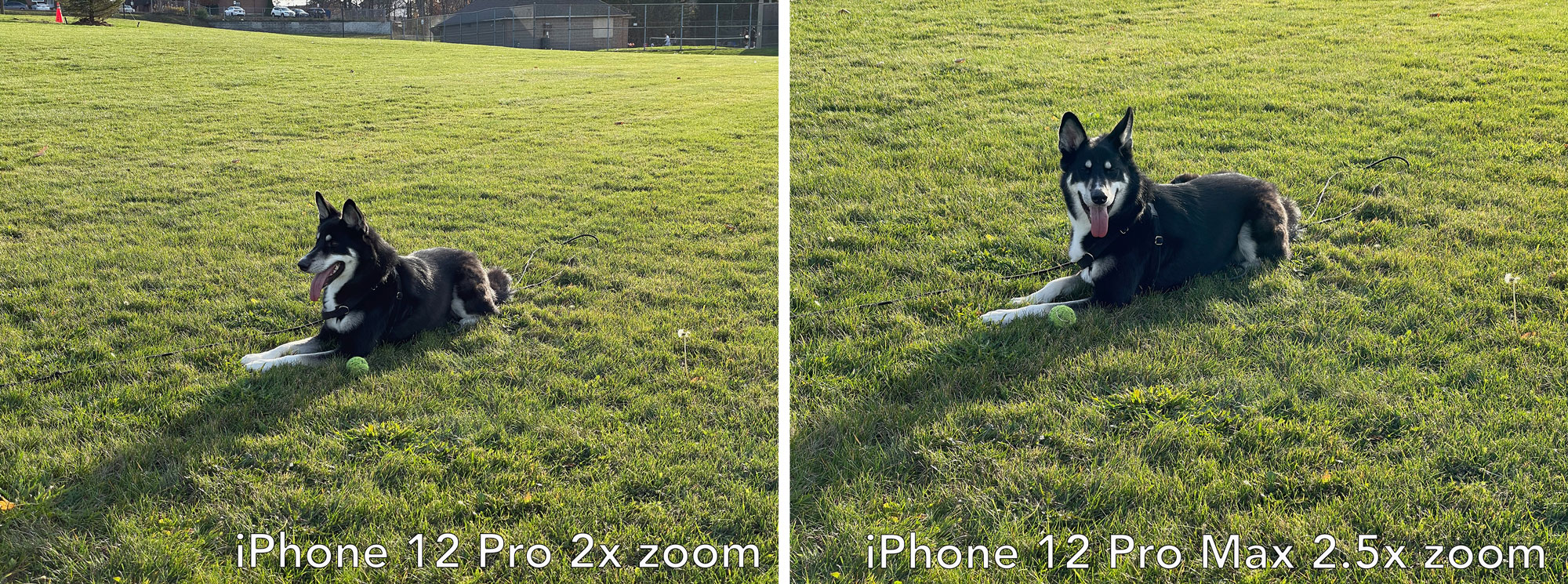
The iPhone 12 Pro’s 2x zoom is on the left and the iPhone 12 Pro Max’s 2.5x zoom is on the right. While 2.5x zoom does allow you to get you closer to the subject you’re shooting, the difference isn’t dramatic.
Other iPhone 12 Pro Max improvements include image stabilization technology more commonly found in DSLRs called ‘sensor shift.’ This technology moves the sensor around multiple axes to stabilize external motion.

Though this feature does make it easier to snap photos quickly, the most significant benefit is that night mode doesn’t need to turn on as often because the iPhone 12 Pro Max is capable of shooting at a slower shutter speed thanks to its sensor shift technology.
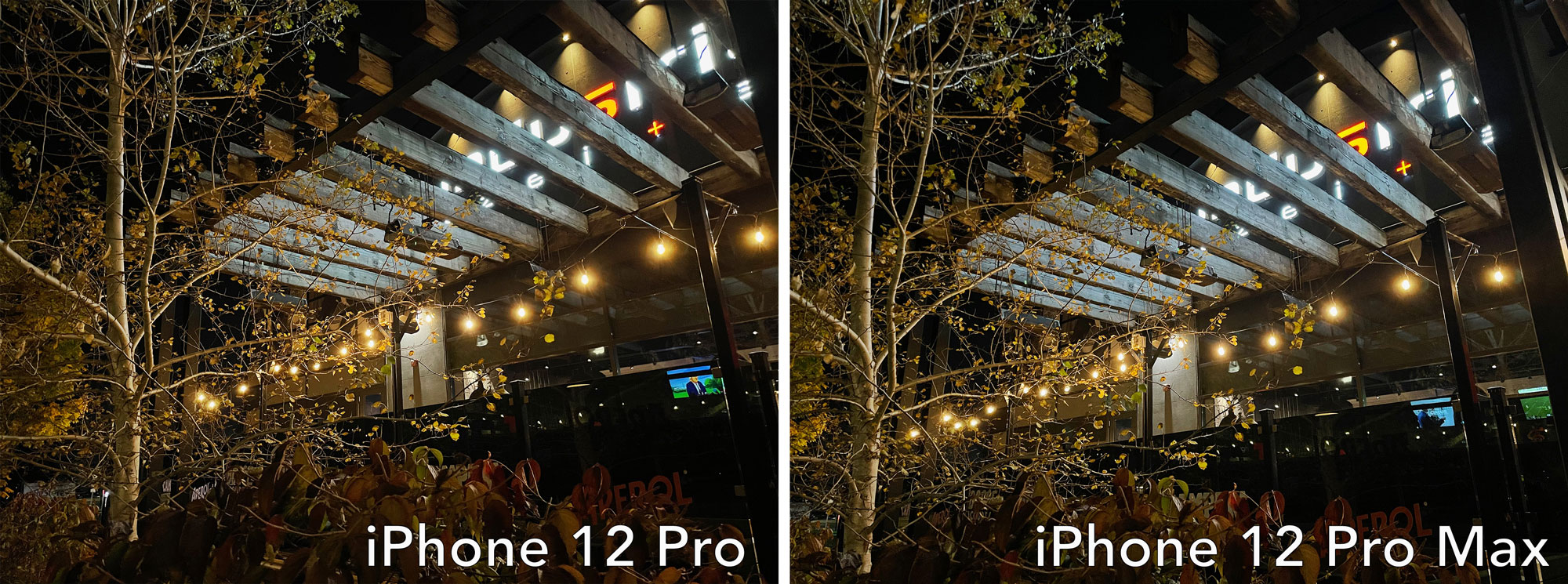
The iPhone 12 Pro’s wide camera is on the left and the iPhone 12 Pro Max’s wide shooter is on the right. The iPhone 12 Pro Max handles highlights slightly better and features generally overall sharper focus, especially in the foliage. However, the difference in quality between the two photos is negligible.
The other major upgrade this year thanks to the new LiDAR sensor is that it’s now possible to snap night mode photos with the ultrawide shooter. Night mode with the ultrawide is a welcome addition and can result in truly stunning vistas. It occasionally blows out highlights, however.
On the other hand, I don’t personally find taking night mode selfies useful, but this feature could come in handy for some people and produces decent shots as long as you’re able to keep still. The difference in quality is really drastic despite it giving skin a weird plastic look. You can also shoot night mode selfies with the camera set to Apple’s depth-of-field Portrait mode.

The iPhone 12 Pro’s selfie shooter in night mode is on the left, and the iPhone 11 Pro Max’s selfie shooter is on the right. Though night mode selfie shots give skin a plastic-like tone, they’re still usable, unlike the dark images the iPhone 11 Pro Max takes.
The most significant upgrade is the speed at which the iPhone 12 Pro and iPhone 12 Pro Max autofocus when under low-light. This is something even the best smartphone cameras often struggle with. Regardless of what I was shooting, I was easily and surprisingly able to quickly focus on the area of the subject I wanted to take a picture of.

The iPhone 12 Pro’s ultrawide camera is on the left, and the iPhone 11 Pro Max’s ultrawide shooter is on the right. The iPhone 12 Pro’s ultrawide camera overall lightens the image and, in most cases, doesn’t feature blown-out highlights.
The iPhone 12 Pro and 12 Pro Max can also shoot 4K/60fps 10-bit Dolby Vision footage in real-time, a first for any smartphone camera. Dolby Vision utilizes dynamic metadata to map accurate colour and the brightness of a scene, which typically requires extensive editing and grading.
“It’s great to see Apple taking RAW photography more seriously, though it’s strange the tech giant still doesn’t offer manual controls in its own camera app”
While the results look impressive and somewhat comparable to my experience watching content on Netflix that supports Dolby Vision, you’ll only be able to actually view the benefits the high-end HDR format provides on supported monitors and televisions. Even then, YouTube doesn’t support Dolby Vision content. Of course, you can also watch Dolby Vision videos directly on the iPhone 12 series.
It’s important to note that the new Apple ProRaw file type announced during the tech giant’s keynote won’t be available at launch, and it’s unclear when it’s releasing. Similar to ‘Deep Fusion,’ it’s likely going to appear at some point in November.

The iPhone 12 Pro’s 12-megapixel selfie shooter is on the left, and the iPhone 11 Pro Max’s selfie camera is on the right. The iPhone 12 Pro more accurately matches my real skin tone and the sky is slightly less overexposed.
That said, it’s great to see Apple taking RAW photography more seriously, though it’s strange the tech giant still doesn’t offer manual controls in its own camera app. What will likely end up being more interesting is how third-party developers take advantage of the ProRaw SDK with their own camera apps.
Don’t upgrade just for 5G
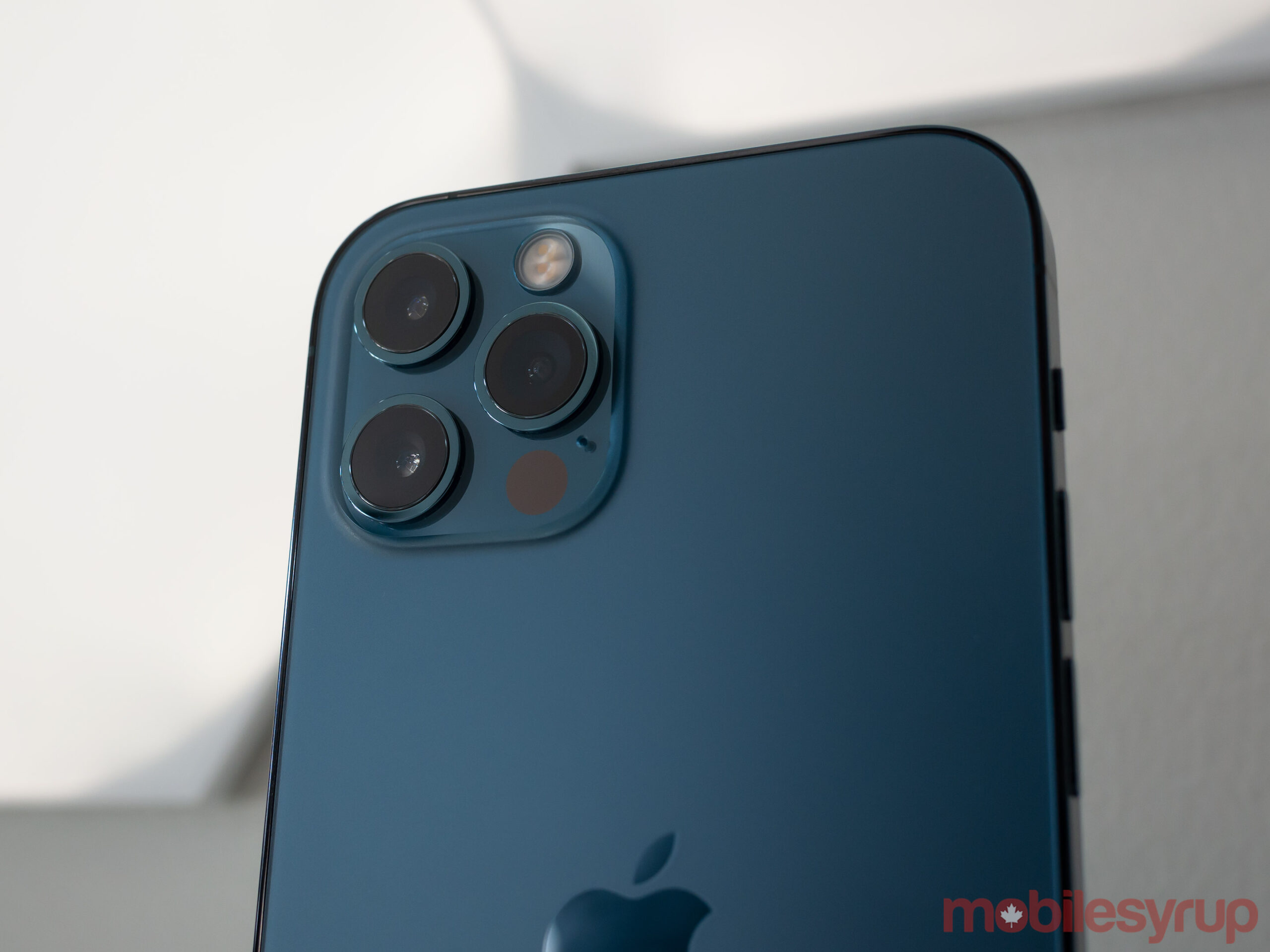
You may have wondered why I didn’t mention 5G as a pivotal new feature at the top of this review. It’s because as much as the Big Three Canadian carriers want you to believe 5G in Canada is a massive jump forward in network speed, the reality is that it isn’t — at least not yet.
I live in Burlington, Ontario, a city that Rogers says it expanded its 5G network to back in late September. I ran several speed tests from my home office, and in nearly every instance, my iPhone 11 Pro Max hit 24.3Mbps download and 10.4Mbps for upload on Rogers’ 5G network, compared to Telus/Koodo’s LTE network hitting 61.7Mbps for download and 3.72Mbps for upload.
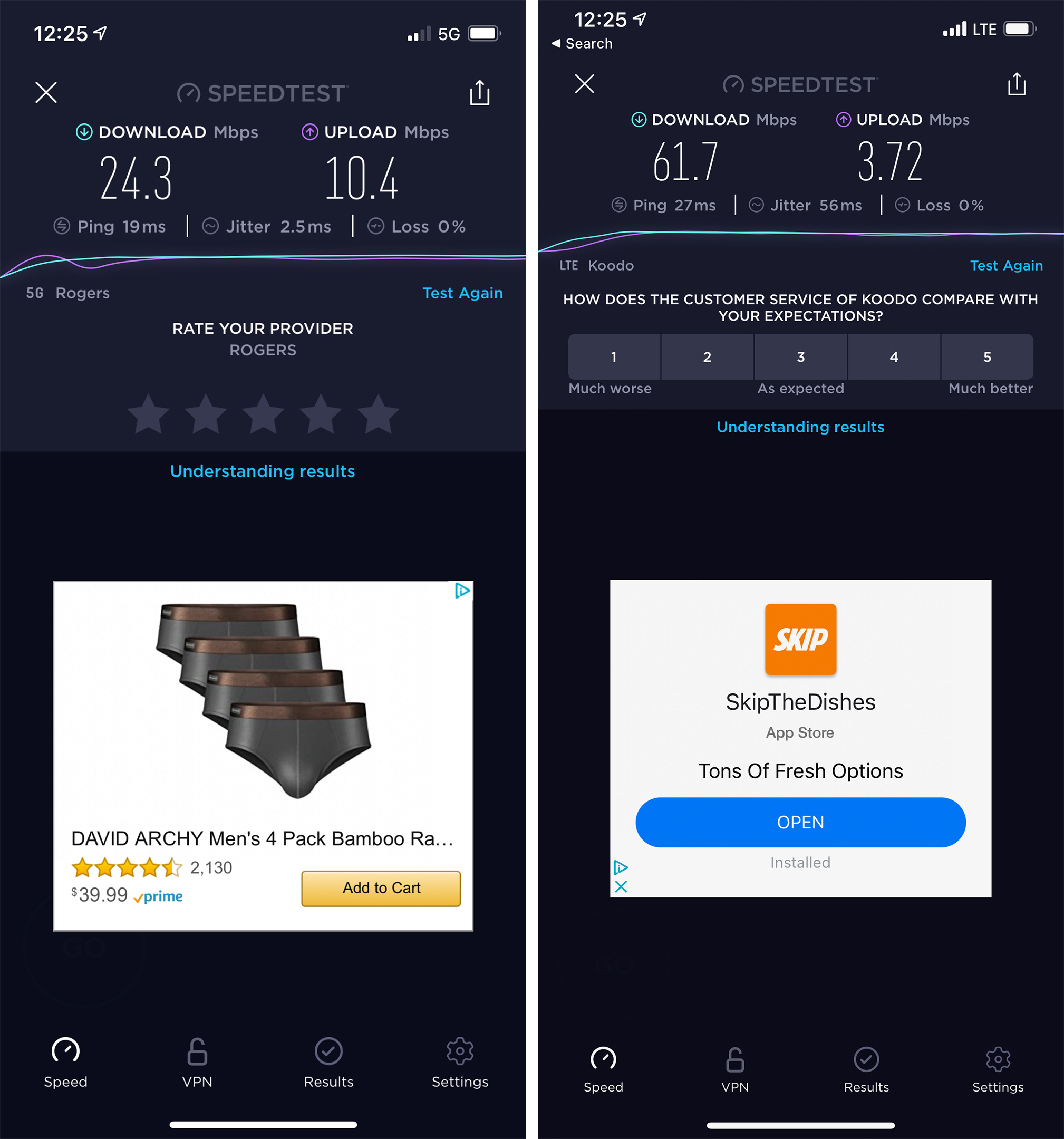
The 5G Rogers test with the iPhone 12 Pro is on the left, and the LTE iPhone 11 Pro Max test with Telus’ LTE network is on the right. This test was performed in Burlington, Ontario. Check out that ad 😂.
That said, I ran several tests in different areas of Oakville, Burlington and Hamilton and across the board, Rogers’ 5G network was typically 10 to 15 percent faster. Still, in the ongoing era when many of us are working from home, the actual speeds you get from your smartphone in your house are important.
Of course, the speeds you receive will shift depending on where you live and whether Rogers’, Bell’s, or Telus’ 5G network is active in your area.
Further, Apple removed the mmWave antenna featured on the side of the U.S. version of iPhone 12 Pro from the iteration of the smartphone sold in Canada. Canadian iPhone 12 smartphones are capable of the n78 5G band (TD 3500), which will likely launch across the country at some point in the next few years.
The Canadian government’s auction for the 3,500MHz spectrum band is set for mid-2021 after being delayed roughly six months due to the ongoing COVID-19 pandemic.
Canadians won’t see the blazing-fast speeds that 5G promises until the 3.5GHz spectrum is auctioned off and deployed in the next few years. The carriers are currently offering 5G by adding 5G channels on top of their existing LTE core.
The iPhone 12 Pro also won’t always be connected to a given carriers’ 5G network, either. Apple’s Smart Data Mode automatically saves power when 5G speeds aren’t needed to improve the smartphone’s battery life. Apple says the device switches between LTE and 5G depending on what you’re doing with your phone. For example, Smart Data Mode could switch to LTE when your screen is off, but if you’re watching Netflix, it might jump back to 5G. That said, you can turn this feature off and lock the iPhone 12 Pro to solely 5G if you want.

Should you just buy the iPhone 12 instead?
Though Apple's iPhone 12 Pro and iPhone 12 Pro Max are impressive, do the devices offer enough advantages over the iPhone 12 now that both smartphones feature nearly identical Super Retina XDR OLED displays? Unless you absolutely need the best of what Apple has to offer and value 2x/2.5x optical zoom, the answer is probably not.
It’s also still unclear if Apple’s upcoming ProRaw format will be worth the additional cost of the iPhone 12 Pro/12 Pro Max.
Still, the iPhone 12 Pro and iPhone 12 Pro Max offer an impressive smartphone package thanks to their worthwhile but incremental camera upgrades, coupled with an excellent design revamp.
The iPhone 12 Pro starts at $1,399 in Canada for the 128GB version . The 256GB iteration costs $1,539 and the 512GB iteration costs $1,809. The iPhone 12 Pro Max starts at $1,549 for the 128GB iteration. The 256GB version costs $1,689 and the 512GB iteration costs $1,959
For my review of the iPhone 12 and iPhone 12 mini, follow this link.
"The iPhone 12 Pro offers an impressive smartphone package thanks to its worthwhile but incremental camera upgrades, coupled with its excellent design revamp"
MobileSyrup may earn a commission from purchases made via our links, which helps fund the journalism we provide free on our website. These links do not influence our editorial content. Support us here.









